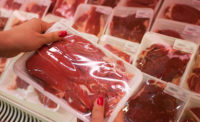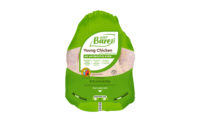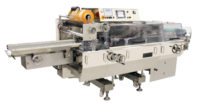Tightly wound

By Richard Mitchell, editor, Meat & Deli Retailer
Overwrap packaging in the meat sector is going through an evolution.
Looking to cut operating expenses and extend the shelf life of proteins, retailers are increasingly leveraging case-ready meats and making store-wrapped cuts less relevant.
The 2007 National Meat Case Study found that case-ready accounted for 64 percent of all packages in supermarket fresh meat cases, up from 60 percent in 2004 and 49 percent in 2002.
The study included analysis of 23,204 packages and 15,982 stock-keeping units (SKUs) in the first quarter of 2007 in stores in all geographic areas of the continental United States.
Case-ready meats typically are merchandised in modified-atmosphere packaging (MAP). The carbon dioxide, nitrogen and oxygen in the packages are formulated to extend the shelf life of proteins. Merchandising of red meats, for instance, can be lengthened from a range of two to four days to a range of five to eight days, analysts say.
Proteins in store-wrapped packages tend to mix with ambient air, which increases the speed of microbial growth and subsequent spoilage.
Yet, while it is less prevalent in meat cases, overwrap still remains the preferred packaging for specific cuts by many retailers particularly ground beef.
With the exposure to oxygen, beef in overwrap packaging “blooms” sooner, resulting in a redder, visually appealing hue that many shoppers perceive as a sign of freshness. Case-ready grinds have a darker appearance.
“Many shoppers won’t buy beef that is losing the bright red state and turning brown around the edges, even if it has nothing do with quality or the eating experience,” says Al Kober, director of retail for Wooster, Ohio-based Certified Angus Beef. “Most consumers mistakenly think beef is freshest when bright red. Yet, beef’s taste generally improves with age, even though its appearance does not.”
That interest by shoppers in meat in overwrap packaging and the continuing use of the packages by many retailers is triggering the launch of enhanced designs. Newer elements are aimed at reducing leakage and improving the products’ appearance.
Kober says purge is the chief complaint consumers voice about fresh-meat packaging, noting that 60 percent to 80 percent of most beef and chicken is water.
“Wet and bloody is the No. 1 hindrance to successfully marketing meats,” he states. “The key to expanding sales is offering proteins in leak-proof packages.”
While some overwrap packages contain antimicrobial pads that are designed to absorb moisture, many shoppers are looking for better solutions, says Huston Keith, principal of packaging research and business-development firm Keymark Associates, and a member of The National Provisioner’s Editorial Board.
“Consumers don’t like handling messy pads or having products drip on them,” he states.
Keith notes, however, that suppliers are working to develop trays that can absorb moisture in lieu of using a pad.
Vendors also are designing anti-fog features. Films, for instance, are being engineered to bead moisture to prevent condensation and provide a clearer view of products.
Certified Angus Beef studies found that shoppers perceive meats in packages with less moisture as being higher quality.
Retailers also can create a more upscale image by using black trays with overwrap film instead of white or yellow containers, Kober notes.
Some merchandisers, meanwhile, are working to attract green-conscious meat buyers by replacing traditional oil-based polystyrene foam trays with sustainable products made from plant-based biopolymer foams that require less fossil fuels and are compostable.
“It is likely that overwrap packaging use will expand further as more butchers start cutting and packaging meats in stores to remain competitive,” says Jarrod Sutton, National Pork Board assistant vice president of channel marketing. “In-store cutting is becoming trendy because many consumers perceive the meat as being fresher.”
In general, larger supermarkets with quicker product turnover will benefit most from overwrap packaging, Kober says.
Smaller grocers with fewer customers are likely to experience higher rates of shrink by marketing meats with shorter shelf lives. Such retailers are chief candidates for case-ready packaging, he states.
Slower-moving products, such as natural and organic proteins, also are often better-suited for case-ready packages, Kober adds.
Yet, while overwrap packaging remains a staple in many meat cases, and elements are being upgraded, few changes are affecting film quality.
Previous film enhancements focused on presentation. They included designs that fit tighter around meats without becoming brittle, and properties that reduced or eliminated fog.
But there is little incentive for film manufacturers to invest further in research and development, Keith notes.
“Many grocers, such as those moving to case-ready meats, are not going to pay more for higher-end overwrap film,” he states. “As a result, suppliers can’t justify spending a lot of money for additional product improvements. It’s similar to creating a better buggy whip. It can be done, but it won’t influence the market much."
Looking for a reprint of this article?
From high-res PDFs to custom plaques, order your copy today!






